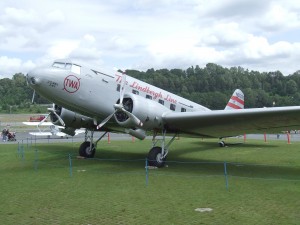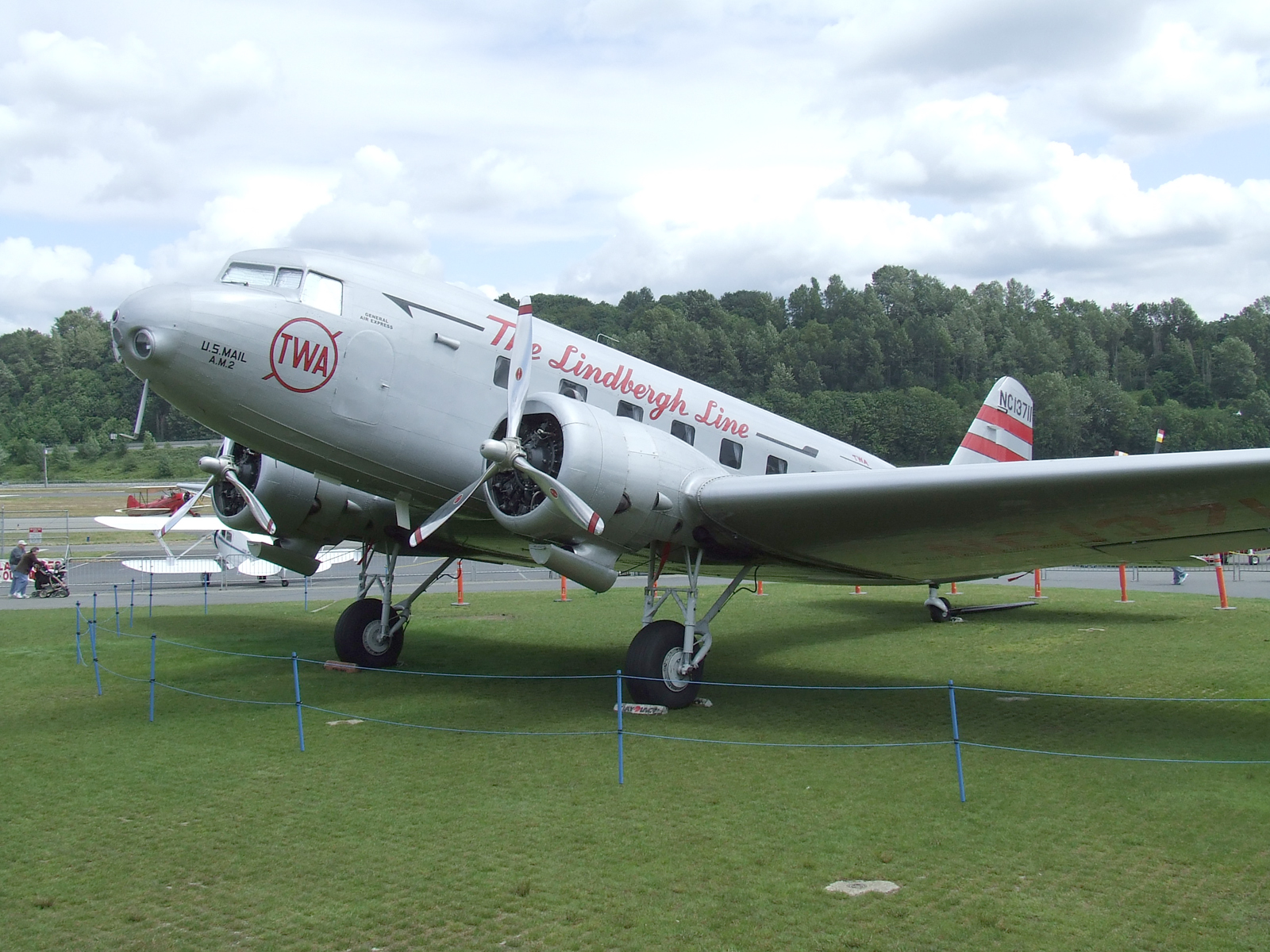By Terry Stephens

This rare Douglas DC-2, at the entrance to Seattle’s Museum of Flight at Boeing Field, is the latest addition to the planes destined for a new commercial aviation wing.
The Museum of Flight at Boeing Field (BFI) in Seattle is the only place in North America where aviation fans and history buffs can see an immaculately restored, flyable DC-2. The twin-engine, 14-seat pioneer of American air travel rests on the museum’s front lawn, dressed in the original gray and red livery of Trans World Airways and The Lindbergh Line.
Credit for adding the rare plane to the museum’s extensive array of air and spacecraft last June goes to members of the board of directors, in particular Clay Lacy, Joe Clark and Bruce McCaw. Several years ago, Lacy, president of Clay Lacy Aviation, and other board members began plans to acquire the DC-2. Cell phone technology developer McCaw said he’d buy the plane for the museum. Lacy said he and board colleague Joe Clark, founder and CEO of Aviation Partners Inc. and founder and chairman of Aviation Partners Boeing, stepped up to cover the cost of its restoration, licensing and operation.
Eventually, the DC-2 will move to the museum’s new Commercial Aviation Wing facility, planned for a site across the street from the museum. Already, the open area displays prototypes of Boeing’s 727, 737 and 747, the 707 that became the first jet-powered Air Force One, and the only supersonic Concorde jetliner on the West Coast. Slated to join the collection will be Boeing’s first airliner, a restored Boeing 247 now housed at Paine Field, plus the only de Havilland Comet in North America, undergoing restoration at the Museum of Flight’s Restoration Center at PAE.
The plane had little rest during its working life. After it rolled out of Douglas Aircraft Co.’s plant in Santa Monica, Calif., the DC-2 was delivered to Pan American Airways in March 1935. It was the first Douglas airliner that saw service outside of the United States, according to Museum of Flight officials. Later, it worked for Pan Am’s affiliate, Mexicana Airlines, and then Aviateca Airlines of Guatemala.
In the mid-1950s, it changed owners again, returning to the United States to begin a variety of roles with Johnson Flying Service in Missoula, Mont. Under contract with the U.S. Forest Service, the plane started out as a general freight hauler, and then became a platform for thousands of firefighting smokejumpers before conversion for a new role as a water bomber.
The sturdy, reliable former airliner proved to be popular wherever it flew, but particularly so during its firefighting tenure with Johnson. Its nimble performance on missions over mountainous country in the western states became legendary. Able to make tight turns in narrow canyons, the DC-2 also performed well in making frequent short-distance landings and takeoffs on backcountry dirt airstrips.
In late 1973, when Evergreen Airlines bought Johnson Flying Service, the DC-2 was sold to Stanley Burnstein, president of Continental Aviation Co. in Tulsa, Okla. A year later, Burnstein donated the DC-2 to the Donald Douglas Museum and Library in Santa Monica, Calif., known today as the Museum of Flying. On its arrival, greeters included both Donald Douglas Sr. and Jr.

L to R: Credit for adding the rare plane to the museum’s extensive array of aircraft goes to members of the board of directors, in particular Joe Clark, Clay Lacy and Bruce McCaw.
Years of sitting on the museum’s parking ramp took its toll, however. The skin began deteriorating, forcing the plane’s move in 1982 to Douglas Aircraft’s Long Beach plant for restoration. Douglas Historical Foundation volunteers invested tens of thousands of hours to restore the aircraft to flying status. One of the more challenging tasks was finding Curtiss Wright R-1920-52 engines, propellers and cockpit instruments to recreate the plane’s 1930s airliner condition. In 1984, it was ready to commemorate the 50th anniversary of its first flight.
The plane returned to static display until The Museum of Flight purchased it in 1997. Pre-flight checks in 2004 revealed the need for more work, including further engine inspections, so Lacy flew it from Long Beach Airport (LGB) to his facility at Van Nuys, Calif. Clay Lacy Aviation’s maintenance workers dedicated more than 3,000 man-hours to restore the airliner once again. After more than 30 hours of flight-testing in dozens of local flights by Lacy and his crew, the DC-2 was ready for its trip to Seattle.
Douglas Aircraft’s DC-2 service began in 1934 at Lambert Field in St. Louis, Mo., now Lambert-St. Louis International Airport (STL). Donald Douglas’ next triumph, the once ubiquitous DC-3, which entered service in 1935, soon overshadowed it in aviation history. But the DC-2 was notable as the challenger that outpaced Boeing’s newly launched 247 airliner, which flew first in 1933 wearing United Airlines’ blue and white colors.
Boeing’s 247 creation was a revolutionary plane, a low-wing design with retractable landing gear, plush seats for its 10 passengers and, for the first time, cabin air conditioning. Its twin engines provided a superior cruising speed of 170 mph compared to the popular Ford Tri-Motor, which cruised at only 115 mph. A derivative of Boeing’s B-9 bomber design, the 247 offered flying performance that eclipsed all other transports of the day. The first transcontinental 247 flight soared from San Francisco to New York City in 19.5 hours, breaking the old commercial service record of 27 hours.
Ironically, Boeing’s impressive launch of its 247 airliner with a 60-plane order from United Airlines worked against its success. Because United Airlines was formed by the merger of Boeing Air Transport, Pacific Air Transport, National Air Transport and Varney Air Lines, production lines were filled with priority United orders. That made it difficult for competing airlines to order the plane, so Trans World Airlines approached Douglas Aircraft to develop its own line of transports. Production of the DC-1, a prototype that launched the famous line of Douglas Commercial models, soon yielded to the company’s first mass-production model: the greatly improved DC-2.
The DC-2’s greater capacity, carrying 14 passengers at faster speeds, quickly overshadowed the revolutionary Boeing 247. Its performance attracted so many orders from U.S. and world airlines that production soon outpaced Boeing’s 247, which left airline service in the early 1940s. Douglas produced 190 models of its DC-2 before it was eclipsed by the DC-3, a workhorse that became a world leader in air transport and military roles for decades. Today, only seven DC-2s exist in the world. Only two of those are airworthy—The Museum of Flight’s aircraft and a restored DC-2 flying in the Netherlands.
An international attraction and the largest independent nonprofit aviation museum in the world, The Museum of Flight’s plans for its six-acre Commercial Aviation Wing include room to house another rare aircraft: one of NASA’s soon-to-be-retired space shuttles. The museum, headed by Dr. Bonnie Dunbar, president and CEO, hopes to obtain its spaceship in 2010, said museum board member Gene McBrayer.
McBrayer, also chairman of the board’s planning committee, said several museums are competing for a shuttle but he’s confident The Museum of Flight will get one of the three first-generation spacecraft. Ultimately, he said, the property will display 16 large aircraft adjacent to the facility displaying the space shuttle.
Adding to the museum’s stature, it was recognized officially last July as an affiliate of the Smithsonian Institution. It’s the only Washington state aviation museum accredited nationally by both the Smithsonian and the American Association of Museums. The Seattle museum now has access to more than 166 million Smithsonian treasures, from art and aircraft to spacecraft. Affiliates can blend Smithsonian artifacts into their own displays, share its education resources and expertise on exhibits, and care for rare, historic collections.
Museum of Flight board chairman Robert Genise said only half of the 51 major aviation museums and science centers in America are accredited by the AAM, and only seven have earned Smithsonian affiliation credentials.
“The Museum of Flight is widely recognized for its outstanding collections, its expert staff and its commitment to public service,” said Harold Closter, director of Smithsonian affiliations. “The museum shares much in common with the Smithsonian, especially with our National Air and Space Museum.”
For more information about The Museum of Flight, visit [http://www.museumofflight.org].











